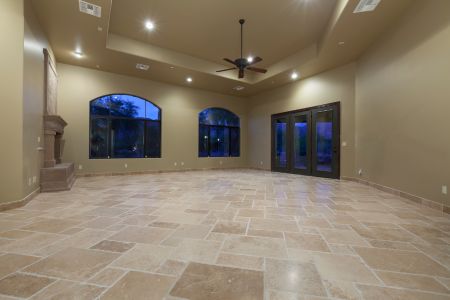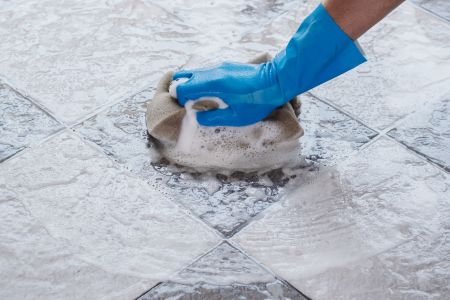Table of Contents
Tailored Tile Tips, Ensuring Every Tile Type Gleams

Walking on a beautifully tiled floor feels fantastic, right? But over time, dirt and grime can dim that shine. Wag kang mag-alala! You’re about to unlock some expert secrets.
Did you know that not all tiles are cleaned the same way? Yes, it’s true! The ceramic tiles in your kitchen might need a different approach than the marble tiles in your living area. So, how do you determine the right way for each type?
You’re in the right place! This guide will share the top cleaning practices for every kind of tile. Imagine having an expert whispering the best advice to you.
Concerned about cleaning your lovely tiles? We’ve gathered the best tips straight from the professionals. When you’re done here, your floors will gleam as if they’re brand new!
Handa ka na ba? Let’s dive in and make those floors sparkle!
Mastering Tile Cleanliness: Techniques for Every Type
How to Clean Ceramic and Porcelain Tile Floors

Ceramic and porcelain tiles are favorites for many homeowners due to their durability and sleek finish. Over time, dirt can accumulate, making them lose their shine. Luckily, with the right cleaning approach, they can be kept looking fresh and new.
What You’ll Need:
- Mild dish soap or tile cleaner available in local stores (e.g., Mr. Muscle, Lysol)
- Bucket
- Soft cloth or sponge
- Soft-bristled brush
- Mop
- Warm water
- Microfiber cloth (for drying)
Steps to Clean:
- Prepare the Area: Start sweeping or vacuuming the tiles to remove loose dirt.
- Make the Cleaning Solution: Mix a few drops of dish soap with warm water in a bucket. If using a tile cleaner, follow the recommended mixing instructions on the label.
- Begin Scrubbing: Dip the soft cloth or sponge into the solution and wring out excess water. Gently scrub the tiles. For stubborn stains, use the soft-bristled brush.
- Mop the Floor: Mop the floor with the cleaning solution after scrubbing. Ensure the mop is well-wrung to prevent excessive wetting of the floor.
- Rinse: Empty the bucket and refill it with clean, warm water. Mop the floor again to remove any soap or cleaner residue.
- Dry: Use the microfiber cloth to dry the tiles, preventing water spots and slips.
Following these steps will keep your ceramic and porcelain tiles clean and radiant.
How to Clean Vinyl Tile Floors

Vinyl tiles are popular due to their affordability and easy maintenance.
Here’s how to keep them looking their best:
- Preparation: Begin by sweeping or vacuuming the tiles to remove dirt and debris.
- Cleaning Solution: Mix a few drops of mild dish soap in a bucket of warm water.
- Mopping: Dip your mop into the cleaning solution, wringing out excess water, then mop the floor, ensuring it does not oversaturate. Vinyl is water-resistant, but it’s still best to avoid pooling water.
- Spot Cleaning: For stubborn stains, apply a small amount of dish soap directly to the stain and gently rub it with a soft cloth or brush.
- Rinse: Wipe the floor with a clean, damp mop or cloth to remove any soap residue.
- Dry: Use a towel or a dry mop to dry the floor, preventing slips and water spots.
Regular cleaning helps maintain the shine and beauty of your vinyl tiles, ensuring they last long and stay looking fresh.
How to Clean Linoleum Tile Floors

Linoleum tiles, known for their eco-friendliness and resilience, can grace your floors for years when maintained properly.
Here’s a straightforward guide to clean them:
- Preparation: Using a soft broom or vacuum, remove loose dirt, dust, and debris.
- Cleaning Solution: Mix a few drops of mild dish soap or baby shampoo in a gallon of warm water. This gentle concoction helps preserve linoleum’s natural sheen.
- Mopping: Immerse a soft mop into your cleaning solution and wring it out well, ensuring it’s damp, not wet. Mop your floor using gentle strokes.
- Tackling Stains: Mix a bit of baking soda with water to form a paste for more stubborn spots. Gently rub the stain using a soft cloth until it disappears, then wipe the area with a clean, damp cloth.
- Rinsing: It’s crucial to ensure no soapy residue remains. Clean the mop and rinse the floor using clean water.
- Drying: Dry the floor using a soft towel or cloth to prevent slips and enhance shine.
Remember, linoleum tiles are sensitive to high-pH cleaners, so it’s best to stick to mild detergents and always test any new cleaning product in an inconspicuous spot first.
How to Clean Natural Stone Tile Floors

Natural stone tiles, including granite, marble, and slate, have an unmatched beauty. However, they require special care to maintain their elegance and charm.
Here’s how you can keep them shining:
- Dust Off: Start by removing loose dirt using a soft broom or a vacuum with a brush attachment. Frequent dusting ensures abrasive dirt particles don’t scratch the stone’s surface.
- Mild Solution: Prepare a cleaning mixture by adding a few drops of neutral pH or stone-specific cleaner into a bucket of warm water. Avoid acidic or alkaline cleaners, as they can damage natural stone.
- Mop Gently: Dip a soft, non-abrasive mop into the solution, wringing it out so it’s damp, not soaked. Mop your floor, periodically rinsing the mop in clean water.
- Stains and Spills: Address any spills promptly with a soft cloth to prevent staining. For tougher stains, use a poultice or a cleaner specifically formulated for natural stone.
- Rinse Thoroughly: It’s essential to rinse off any cleaning residue. Use a clean mop and fresh water, ensuring the mop remains damp.
- Dry Completely: Dry the tiles with a soft cloth to prevent water spots or mineral residues.
- Seal the Deal: Natural stone is porous and susceptible to staining. Consider sealing your tiles every couple of years, or as recommended, to protect them from spills and stains.
By giving your natural stone tiles the gentle care they deserve, you’ll ensure they retain their elegance for years.
How to Clean Marble Tile Floors

Marble tiles exude luxury and elegance. However, marble requires special attention to prevent damage and keep its sheen intact because it is a soft and porous stone.
Here’s how you can maintain its pristine beauty:
- Regular Sweeping: Start by removing surface dirt using a soft broom or a vacuum with a brush attachment. This helps to avoid scratches from abrasive dirt particles.
- Avoid Acidic Cleaners: Marble can easily etch or lose its shine when exposed to acidic substances. Hence, avoid using vinegar, lemon, or any acidic cleaner. Instead, opt for a pH-neutral or marble-specific cleaner.
- Mild Soapy Solution: Mix a few drops of mild dish soap in warm water. Use this solution to mop the marble floor gently.
- Tackle Spills Immediately: Marble can stain quickly. Wipe off any spills, especially acidic ones like citrus or tomato sauce, immediately using a soft cloth.
- Rinse with Clean Water: After mopping, rinse the floor with clean water to remove soap residues. Ensure the mop is damp and not soaking wet.
- Dry the Floor: Marble can spot. To prevent water spots, dry the floor using a soft towel or cloth immediately after cleaning.
- Polishing: If your marble floor loses its luster, consider using a commercial marble polish to restore its shine.
- Seal the Surface: To guard against stains and enhance the life of your marble tiles, apply a marble sealer every year or as often as required.
With proper care, your marble tile floors will remain a centerpiece of beauty in your home for a long time.
How to Clean Terracotta Tile Floors

Terracotta tiles add warmth to any space with their earthy tones and rustic charm. These tiles are made from natural clay, making them porous and absorbent. It’s essential to handle them with care to maintain their beautiful appearance.
Here’s how to give them a gentle yet effective clean:
- Regular Dusting: Dust or sweep terracotta tiles daily with a soft brush or microfiber mop to keep abrasive dirt and grit from scratching the surface.
- Avoid Harsh Chemicals: Steer clear of acidic or alkaline cleaners, which can damage the tile. Instead, use a pH-neutral or tile-specific cleaning solution.
- Mild Soapy Solution: Mix a few drops of mild dish soap in warm water. Use this diluted solution to mop the terracotta tiles. Ensure your mop is damp, not drenched, to avoid over-wetting the tiles.
- Tackle Spills Promptly: Terracotta tiles can stain easily due to their porous nature. Clean up spills immediately with a soft cloth to prevent them from seeping into the tile.
- Rinse and Dry: After cleaning, rinse the tiles with clean water to remove any soap residues. Promptly dry them using a soft towel to prevent water marks.
- Sealing is Key: Since terracotta tiles are porous, sealing them is essential to prevent stains and make cleaning easier. Depending on foot traffic and wear, reseal the tiles every 2-3 years or as needed.
- Avoid Wax or Oil-based Cleaners: These can darken the tiles and make them appear patchy.
By following these steps, you can keep your terracotta tiles looking vibrant and well-maintained, enhancing the natural beauty of your home.
How often should you clean tile floors?
Tile floors should be swept or vacuumed daily to remove dust and debris for regular maintenance. A more thorough cleaning using a suitable tile cleaner should be done weekly. However, high-traffic areas or tiles exposed to frequent spills may require more frequent cleanings. Always address spills immediately to prevent staining.
Why is my floor sticky after I mop?
A sticky floor after mopping can be due to several factors:
- Overusing floor cleaner or not rinsing the mop well.
- Mopping with dirty water.
- Residue build-up from previous cleanings.
- Using specific oil-based cleansers.
- Residue from hard water.
To fix it, try mopping with a diluted white vinegar solution to remove the stickiness. Ensure to test a small area first to avoid potential damage.
Conclusion
Maintaining sparkling tile floors isn’t just about the aesthetics; it’s also about the longevity of your flooring. By understanding the unique needs of each tile type and addressing them accordingly, you ensure a longer-lasting shine and durability. Regular cleaning and the right techniques will uplift your space’s overall look and provide a healthier environment for you and your loved ones. Remember, consistency is key, and a little effort goes a long way in preserving the beauty and integrity of your floors. So, roll up those sleeves and let your tiles shine bright, reflecting the care and love you put into your home.
